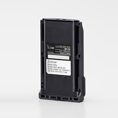Types of Two Way Radio Batteries & Battery Care
 |
 |
||
| Rechargeable Battery Pack | Alkaline Battery Case | ||
Commercial handheld two-way radios use a variety of battery types. Most radios have the option to either use an alkaline battery case which uses disposable batteries or a rechargeable battery pack. Rechargeable batteries are also called "rechargeable battery packs". Battery packs consist of several individual batteries permanently wired together. Since most radios today come with a rechargeable battery pack, if you wish to use disposable batteries then you will need to purchase an alkaline battery case for disposable batteries. The alkaline battery pack holds the disposable batteries in the radio's battery compartment, usually either AA or AAA batteries.
If you plan to use your radio for emergency communications then it’s a good idea to have a battery case for disposable batteries on-hand, since you may not have a power source to recharge your battery pack.
There are primarily 3 types of rechargeable battery packs sold today for use in handheld two-way radios.
3 Types of Rechargeable Batteries
| NiCd | (Nickel Cadmium) Today’s NiCd batteries are largely free of any ‘memory effect’ problem (where batteries lose the ability to fully recharge over time). However, these batteries are being phased out in favor of NiMH or Li-Ion batteries. | |
| NiMH | (Nickel Metal Hydride) Improved performance over NiCd batteries. These batteries have comparable performance to top-quality alkaline batteries. | |
| Li-Ion | (Lithium-Ion) These batteries are the best in battery development. They can be recharged quickly and many times over. Many radio manufacturers have moved to this battery technology for their newer model radios. |
Making Your Battery Last
These battery basics will help you extend the life of your rechargeable battery.
- For new batteries; charge your battery overnight before using it the first time. This is referred to as "initializing your battery". Refer to your user’s manual for charging times.
- New “non-initialized” (uncharged) batteries can be stored in a cool, dry, well-ventilated area for extended periods (check your user’s manual).
- Do not leave your radio with your fully charged battery in the charger when not being charged. Continuous charging is not recommended.
- For older NiCd or NiMH batteries, only charge a battery when it is fully discharged. When older NiCd or NiMH batteries are consistently recharged before draining all power, they can develop ‘ memory effect’, limiting the battery’s ability to accept a full charge. This results in a battery that works for a short time and needs recharging more frequently.
- We suggest you use each battery until fully discharged and carry a spare battery. It is best not to return charged batteries to the charger for an ‘extra boost’.
- Protect your batteries from extreme temperatures. Never freeze a battery. Charging below 40° F and above 104° F will decrease a battery’s life.
- Batteries which have been in storage for more than 6 weeks should be fully discharged and recharged.
